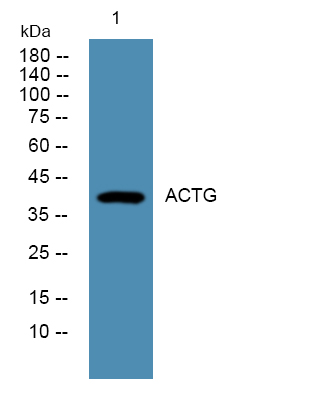ACTG Polyclonal Antibody
- Catalog No.:YN1908
- Applications:WB;ELISA
- Reactivity:Human;Rat;Mouse
- Target:
- ACTG
- Fields:
- >>Rap1 signaling pathway;>>Phagosome;>>Apoptosis;>>Hippo signaling pathway;>>Focal adhesion;>>Adherens junction;>>Tight junction;>>Platelet activation;>>Neutrophil extracellular trap formation;>>Leukocyte transendothelial migration;>>Thermogenesis;>>Regulation of actin cytoskeleton;>>Thyroid hormone signaling pathway;>>Oxytocin signaling pathway;>>Gastric acid secretion;>>Amyotrophic lateral sclerosis;>>Bacterial invasion of epithelial cells;>>Vibrio cholerae infection;>>Pathogenic Escherichia coli infection;>>Shigellosis;>>Salmonella infection;>>Yersinia infection;>>Influenza A;>>Proteoglycans in cancer;>>Hepatocellular carcinoma;>>Hypertrophic cardiomyopathy;>>Arrhythmogenic right ventricular cardiomyopathy;>>Dilated cardiomyopathy;>>Viral myocarditis;>>Fluid shear stress and atherosclerosis
- Gene Name:
- ACTG1 ACTB ACTG
- Protein Name:
- Actin, cytoplasmic 2 (Gamma-actin) [Cleaved into: Actin, cytoplasmic 2, N-terminally processed]
- Human Gene Id:
- 71
- Human Swiss Prot No:
- P63261
- Mouse Swiss Prot No:
- P63260
- Rat Swiss Prot No:
- P63259
- Immunogen:
- Synthesized peptide derived from part region of human protein
- Specificity:
- ACTG Polyclonal Antibody detects endogenous levels of protein.
- Formulation:
- Liquid in PBS containing 50% glycerol, and 0.02% sodium azide.
- Source:
- Polyclonal, Rabbit,IgG
- Dilution:
- WB 1:500-2000 ELISA 1:5000-20000
- Purification:
- The antibody was affinity-purified from rabbit antiserum by affinity-chromatography using epitope-specific immunogen.
- Concentration:
- 1 mg/ml
- Storage Stability:
- -15°C to -25°C/1 year(Do not lower than -25°C)
- Observed Band(KD):
- 41kD
- Background:
- Actins are highly conserved proteins that are involved in various types of cell motility, and maintenance of the cytoskeleton. In vertebrates, three main groups of actin isoforms, alpha, beta and gamma have been identified. The alpha actins are found in muscle tissues and are a major constituent of the contractile apparatus. The beta and gamma actins co-exist in most cell types as components of the cytoskeleton, and as mediators of internal cell motility. Actin, gamma 1, encoded by this gene, is a cytoplasmic actin found in non-muscle cells. Mutations in this gene are associated with DFNA20/26, a subtype of autosomal dominant non-syndromic sensorineural progressive hearing loss. Alternative splicing results in multiple transcript variants.[provided by RefSeq, Jan 2011],
- Function:
- disease:Defects in ACTG1 are the cause of non-syndromic sensorineural deafness autosomal dominant type 20 (DFNA20) [MIM:604717]; also called autosomal dominant deafness type 26 (DFNA26). DFNA20 is a form of sensorineural hearing loss. Sensorineural deafness results from damage to the neural receptors of the inner ear, the nerve pathways to the brain, or the area of the brain that receives sound information.,function:Actins are highly conserved proteins that are involved in various types of cell motility and are ubiquitously expressed in all eukaryotic cells.,miscellaneous:In vertebrates 3 main groups of actin isoforms, alpha, beta and gamma have been identified. The alpha actins are found in muscle tissues and are a major constituent of the contractile apparatus. The beta and gamma actins coexist in most cell types as components of the cytoskeleton and as mediators of internal cell motil
- Subcellular Location:
- Cytoplasm, cytoskeleton .
- Expression:
- B-cell,B-cell lymphoma,Brain,Cajal-Retzius cell,Eye,Hepatocellular carcinoma,Lung,Muscle,No
- June 19-2018
- WESTERN IMMUNOBLOTTING PROTOCOL
- June 19-2018
- IMMUNOHISTOCHEMISTRY-PARAFFIN PROTOCOL
- June 19-2018
- IMMUNOFLUORESCENCE PROTOCOL
- September 08-2020
- FLOW-CYTOMEYRT-PROTOCOL
- May 20-2022
- Cell-Based ELISA│解您多样本WB检测之困扰
- July 13-2018
- CELL-BASED-ELISA-PROTOCOL-FOR-ACETYL-PROTEIN
- July 13-2018
- CELL-BASED-ELISA-PROTOCOL-FOR-PHOSPHO-PROTEIN
- July 13-2018
- Antibody-FAQs
- Products Images

- Western blot analysis of lysates from KB cells, primary antibody was diluted at 1:1000, 4°over night



